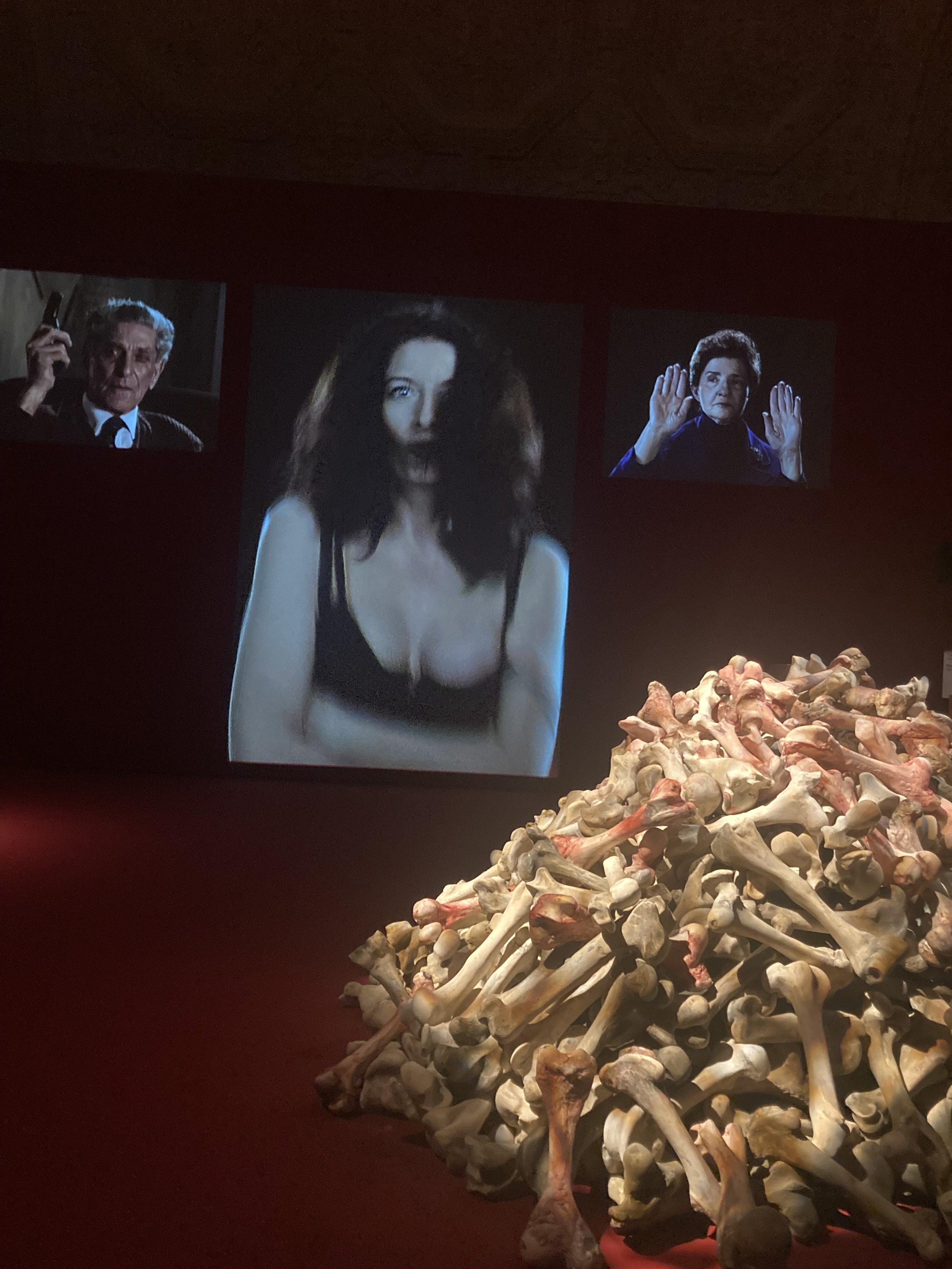Would You Squeeze Between a Naked Couple?
Balkan Baroque at the Royal Academy, London
Natasha’s dance in War and Peace is something indicative of the existence of a blood culture: something that runs through our veins that connects us to something intangible. Any of my friends who have seen me dance to a song with strong drums or, God forbid, anything written by a Scotsman, will remark on how I dance a strange hop and a skip (usually a very bad attempt at pas de basque). Followed by manic, yet somehow rhythmic clapping with my arms above my head and the stomping of my right foot.
Marina Abramovic’s Balkan Baroque contains a similar vignette: a video of her telling a gruesome Serbian folk story wearing a large white lab coat and flanked by images of her parents in various poses, hands on their heart, covering their eyes, arms up in surrender, eyes wide in shock… She then finishes the story and removes the coat revealing a strappy black dress. She begins to dance a Hungarian Czardas (a folk dance), stompy rhythmic steps not quite in time with the music. Pulling a skein of red fabric from between her breasts it becomes part of the dance as she flings and wafts it. The fabric becomes an extension of her hands and wrists.
At the Royal Academy exhibition, this video plays behind a pile of ‘bones’, (a smaller reproduction of the piece at MoMA) that she had cleaned of blood in 1997 to symbolise and protest the Bosniak Genocide that was taking place in former Yugoslavia. Predominantly undertaken by Serbian paramilitary forces.
About the piece she says: ‘The whole idea that by washing bones and trying to scrub the blood, is impossible. You can't wash the blood from your hands as you can't wash the shame from the war’. The first performance took place in Venice during the summer, she diligently scrubbed this bloody pile of remains for days, as time progressed the smell was ‘unbearable’ and the bones began to fester and swarm with worms.
The physicality of Abramovic’s art catalyses the transcendentalism that she so desires . She delves into the extremes of humanity, creating beauty in violence and terror in desire. Sex and sexuality is key to humanity but there is no sensuality to it . What was fascinating about the Royal Academy’s exhibition was how doctored this was. Imponderabilia was probably the best example: in the initial performance with Abramovic and Ulay, people who came to see the work had no choice but to squeeze through the naked pair; at the Royal Academy there was a separate door for the squeamish.
A group of four of us hovered before the pair standing to attention:
Are we going through?
I think we have to
We’re going through, right? All of us?
All of us facing the woman went through one by one, me last and I murmured a quick sorryyyy to the woman, desperately aiming my eyes at the crown of her head. Ever the Brit .
The measures that the Royal Academy put in place are understandable in our modern world. obviously the models have consented to their nudity, but the general public haven’t necessarily consented to being faced with a pair of breasts. The same goes for a lot of her works, no one can or should perform Rhythmn 0 again. The reproduction of the original table was ghastly and grizzly to see: everything from an Italian fashion magazine to hacksaws and meat cleavers were neatly lined up like a tetris panel that would give Jigsaw an orgasm. I dread to think what would happen if a young woman attempted a re-enactment at present: men and women are more equal than they were in 1974, but I think porn culture and access to the internet have given birth to a strange contradiction in the emancipation of women. Fetishization, exploitation and violence have become strangely interwoven into narratives about sex. It’s ‘vanilla’ to not want to be slapped in bed. It was men who acted violently to Marina in 1974; and fifty years later, faced with the same table and a young woman – it would pour luminous liquid through the cracks in our civilised society.
Nevertheless, the sanitisation of her works is also really quite tragic, but not for the obvious reasons. If we are going to face this ugliness of modern society, we need to do it in a way that does not evade it, for example by making another door. Abramovic herself has admitted she was conflicted about the compromises she had made to facilitate the exhibition with the Royal Academy, but soothes herself that this is the only way her work can be experienced by new generations. For a woman whose career has spanned the extremes of human capacities for pain and endurance, her irritation is understandable – though when she can no longer perform, she has to adapt them. For the ‘sexier’ performances, however, the amendments dismantle the initial point entirely. There is an argument that Imponderabilia should be no different from squeezing through two people in a crowd – a simple murmured apology, but no other potential awkwardness. Obvious practicalities aside, it feels as though the sanitisation of Abramovic’s work has removed eponymous ‘presence’ of the artist .
These precautions prove that Abramovic is still as shocking as she was in the seventies, and if anything, we have done nothing to force the changes that she endeavours to instil. If the ‘grandmother of performance art’ is still ground breaking in her creations of new views of confronting pain and the body, we need to actually use it to study our own humanity. It is reductive to hide from an uncomfortable violence that has the potential to be remedied, by simply walking around it .
